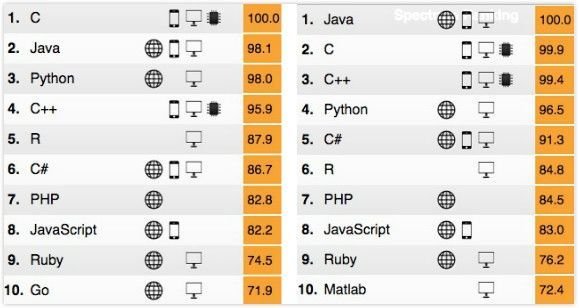R Script
Introduction and Practice -1
Shawn Chen 2016.8.13
R語言簡介
面對撲面而來的資料浪潮,包含 Google、Facebook、Intel、Pfizer、Bank of America 等國際級企業,都已經採用 R 語言進行資料分析,許多全球一流大學如 Stanford、Johns Hopkins 和 UCLA 也將 R 視為資料分析課程的先修科目。R 語言具有免費、跨平台、佔有率高、可塑性高等優勢,各式各樣的 R 社群蓬勃發展。在國際知名的 KDnuggets 論壇統計當中,R 語言已經連續三年獲得資料科學家最常使用的資料分析語言第一名。

IEEE Spectrum Rank

Let's try it!
If you do not finish RStudio downloading, use this link.

RStudio Interface

Try it!

> x <- 10
> y <- "IBM"
>Try it!

> x <- 10
> y <- "IBM"
> z <- rnorm(1000, mean = 100, sd = 5)
>rnorm?

> z <- rnorm(1000, mean = 100, sd = 5)
> ?rnorm
>rnorm

> z <- rnorm(1000, mean = 100, sd = 5)
> ?rnorm
> zrnorm

> z <- rnorm(1000, mean = 100, sd = 5)
> ?rnorm
> z
> hist(z)
>Exercise 1
Display the histogram of normal distribution with 1000 numbers, average 10 and standard deviation 10
Exercise 1

> hist(rnorm(1000, mean = 10, sd = 10))
>
R Data Structure
R's Basic Data Types
- Integer
- Numeric
- Complex
- Character
- Logical
Data Types
> class(x)
[1] "numeric"
> class(y)
[1] "character"
>
Data Types
> class(x)
[1] "numeric"
> class(z)
[1] "numeric"
> class(z)
[1] "numeric"
> 
Data Types
> x <- 10
> class(x)
[1] "numeric"
> x <- as.integer(x)
> class(x)
[1] "integer"
> 
Data Types
> x <- 10
> class(x)
[1] "numeric"
> x <- as.integer(x)
> class(x)
[1] "integer"
> y <- as.integer(y)
Warning message:
NAs introduced by coercion 
General Data Structures
- Vector
- Matrix
- Array
- List
- Data Frame
Vector
The basic data object in R,
consisting of one or more values of
a single data type.
Matrix
A two-dimensional of a single data type.
Array
A multi-dimensional object of a single data type.
Data Frame
A special kind of named list where all elements has the same length.
List
A list can contain (multi) dimensional objects of any data type.
Vector
Matrix
Array
DataFrame
List
Practice
Create Vector
> V <- c(10, 5, 3, 1, 0)
> class(V)
[1] "numeric"
> 
Create Vector
> V <- c(10, 5, 3, 1, 0)
> class(V)
[1] "numeric"
> V <- as.integer(V)
> class(V)
[1] "integer"
> 
Create Vector
> V2 <- c(1, 2, NA, NA, 5)
> V2[1]
[1] 1
> V2[4]
[1] NA
> 
Create Vector
> V3 <- 1:10
> V3
[1] 1 2 3 4 5 6 7 8 9 10
> 
Exercise2
Copy of deck
By Chen Hsiang-wen
Copy of deck
- 371
